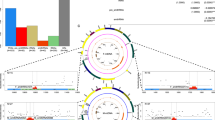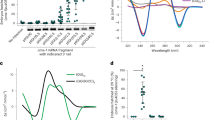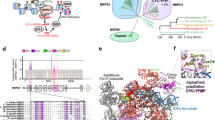Abstract
Eukaryotic cells express a wide variety of endogenous small regulatory RNAs that regulate heterochromatin formation, developmental timing, defence against parasitic nucleic acids and genome rearrangement. Many small regulatory RNAs are thought to function in nuclei1,2. For instance, in plants and fungi, short interfering RNA (siRNAs) associate with nascent transcripts and direct chromatin and/or DNA modifications1,2. To understand further the biological roles of small regulatory RNAs, we conducted a genetic screen to identify factors required for RNA interference (RNAi) in Caenorhabditis elegans nuclei3. Here we show that the gene nuclear RNAi defective-2 (nrde-2) encodes an evolutionarily conserved protein that is required for siRNA-mediated silencing in nuclei. NRDE-2 associates with the Argonaute protein NRDE-3 within nuclei and is recruited by NRDE-3/siRNA complexes to nascent transcripts that have been targeted by RNAi. We find that nuclear-localized siRNAs direct an NRDE-2-dependent silencing of pre-messenger RNAs (pre-mRNAs) 3′ to sites of RNAi, an NRDE-2-dependent accumulation of RNA polymerase (RNAP) II at genomic loci targeted by RNAi, and NRDE-2-dependent decreases in RNAP II occupancy and RNAP II transcriptional activity 3′ to sites of RNAi. These results define NRDE-2 as a component of the nuclear RNAi machinery and demonstrate that metazoan siRNAs can silence nuclear-localized RNAs co-transcriptionally. In addition, these results establish a novel mode of RNAP II regulation: siRNA-directed recruitment of NRDE factors that inhibit RNAP II during the elongation phase of transcription.
This is a preview of subscription content, access via your institution
Access options
Subscribe to this journal
Receive 51 print issues and online access
$199.00 per year
only $3.90 per issue
Buy this article
- Purchase on SpringerLink
- Instant access to full article PDF
Prices may be subject to local taxes which are calculated during checkout




Similar content being viewed by others
References
Matzke, M. A. & Birchler, J. A. RNAi-mediated pathways in the nucleus. Nature Rev. Genet. 6, 24–35 (2005)
Moazed, D. Small RNAs in transcriptional gene silencing and genome defence. Nature 457, 413–420 (2009)
Guang, S. et al. An Argonaute transports siRNAs from the cytoplasm to the nucleus. Science 321, 537–541 (2008)
Montgomery, M. K., Xu, S. & Fire, A. RNA as a target of double-stranded RNA-mediated genetic interference in Caenorhabditis elegans. Proc. Natl Acad. Sci. USA 95, 15502–15507 (1998)
Clark, S. G., Lu, X. & Horvitz, H. R. The Caenorhabditis elegans locus lin-15, a negative regulator of a tyrosine kinase signaling pathway, encodes two different proteins. Genetics 137, 987–997 (1994)
Huang, L. S., Tzou, P. & Sternberg, P. W. The lin-15 locus encodes two negative regulators of Caenorhabditis elegans vulval development. Mol. Biol. Cell 5, 395–411 (1994)
Tatusov, R. L. et al. The COG database: an updated version includes eukaryotes. BMC Bioinformatics 4, 41–55 (2003)
Djupedal, I. et al. RNA Pol II subunit Rpb7 promotes centromeric transcription and RNAi-directed chromatin silencing. Genes Dev. 19, 2301–2306 (2005)
Moore, M. J. & Proudfoot, N. J. Pre-mRNA processing reaches back to transcription and ahead to translation. Cell 136, 688–700 (2009)
Rogalski, T. M., Golomb, M. & Riddle, D. L. Mutant Caenorhabditis elegans RNA polymerase II with a 20,000-fold reduced sensitivity to α-amanitin. Genetics 126, 889–898 (1990)
Liu, J. et al. Argonaute2 is the catalytic engine of mammalian RNAi. Science 305, 1437–1441 (2004)
Yigit, E. et al. Analysis of the C. elegans Argonaute family reveals that distinct Argonautes act sequentially during RNAi. Cell 127, 747–757 (2006)
Duchaine, T. F. et al. Functional proteomics reveals the biochemical niche of C. elegans DCR-1 in multiple small-RNA-mediated pathways. Cell 124, 343–354 (2006)
Lee, R. C., Hammell, C. M. & Ambros, V. Interacting endogenous and exogenous RNAi pathways in Caenorhabditis elegans. RNA 12, 589–597 (2006)
Timmons, L., Court, D. L. & Fire, A. Ingestion of bacterially expressed dsRNAs can produce specific and potent genetic interference in Caenorhabditis elegans. Gene 263, 103–112 (2001)
Kamath, R. S. et al. Systematic functional analysis of the Caenorhabditis elegans genome using RNAi. Nature 421, 231–237 (2003)
Bosher, J. M., Dufourcq, P., Sookhareea, S. & Labouesse, M. RNA interference can target pre-mRNA: consequences for gene expression in a Caenorhabditis elegans operon. Genetics 153, 1245–1256 (1999)
Kennedy, S., Wang, D. & Ruvkun, G. A conserved siRNA-degrading RNase negatively regulates RNA interference in C. elegans. Nature 427, 645–649 (2004)
Berezikov, E., Bargmann, C. I. & Plasterk, R. H. Homologous gene targeting in Caenorhabditis elegans by biolistic transformation. Nucleic Acids Res. 32, e40 (2004)
Core, L. J., Waterfall, J. J. & Lis, J. T. Nascent RNA sequencing reveals widespread pausing and divergent initiation at human promoters. Science 322, 1845–1848 (2008)
Acknowledgements
We thank P. Anderson, members of the Anderson laboratory, D. Wassarman and D. Brow for comments, and the Caenorhabditis Genetics Center for strains. This work was supported by grants from the Pew and Shaw scholars programmes, the National Institutes of Health and the American Heart Association.
Author information
Authors and Affiliations
Contributions
S.G. performed genetic screening, generated constructs and contributed to Figs 1a, 2b, c, 3b, e, 4a and Supplementary Figs 2, 6, 7 and 9–12. A.F.B. mapped nrde-2, generated transgenic lines and contributed to Fig. 1c, d and Supplementary Figs 3 and 5. K.B.B. contributed to Fig. 1b and Supplementary Figs 3 and 8. N.B. contributed to Fig. 3a and Supplementary Fig. 8. D.M.P. contributed to Fig. 2a. S.K. wrote the paper and contributed to Figs 2d, 3c, d, 4b–d and Supplementary Figs 1, 2, 13 and 14.
Corresponding author
Ethics declarations
Competing interests
The authors declare no competing financial interests.
Supplementary information
Supplementary Information
This file contains Supplementary Figures S1-S14 with legends and References. (PDF 8948 kb)
Rights and permissions
About this article
Cite this article
Guang, S., Bochner, A., Burkhart, K. et al. Small regulatory RNAs inhibit RNA polymerase II during the elongation phase of transcription. Nature 465, 1097–1101 (2010). https://doi.org/10.1038/nature09095
Received:
Accepted:
Published:
Issue Date:
DOI: https://doi.org/10.1038/nature09095



